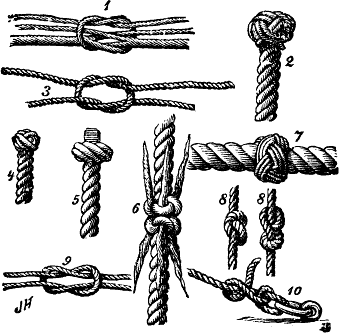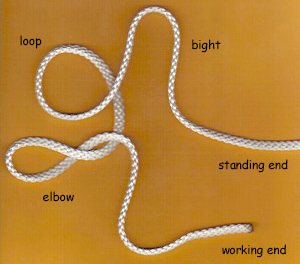|
ROPE - KNOTS
|
|
A knot is a method for fastening or securing linear material such as rope by tying or interweaving, it is also a measure of speed of a boat over water. It may consist of a length of one or more segments of rope, cord, webbing, twine, string, strap or even chain interwoven so as to create in the line the ability to bind to itself or to some other object - the "load". Knots have been the subject of interest both for their ancient origins, common use, and the mathematical implications of knot theory.
Every would be sailor must know his or her ropes and become familiar with some common knots, just to be able to tie up a boat to a jetty. Then there is anchoring, then safety at sea. There are all kinds of rope and all kinds of knots, each with a different use. A 'Knot' is also a measure of speed in water, which gains its name from the distance between two knots of a piece of rope.
Usage
Some knots are well adapted to bind to particular objects such as another rope, cleat, ring, stake or to constrict an object. Decorative knots usually bind to themselves to produce attractive patterns.
Knots are essential in many industrial, work, home or recreational activities. Even simple activities such as running a load from the hardware store to home can result in disaster if a clumsy twist in a cord passes for a knot. Truckers needing to tie down a load may use a trucker's hitch, gaining mechanical advantage. Knots can save the spelunker from foolishly becoming buried under millions of tons of rock. Whatever the activity, on the water sailing or on a cliff-side rock climbing, learning well tested knots prior to some hazardous activity introduces a critical measure of safety. In addition to safety, appropriate knots can prevent the necessity of cutting lines.
In ropework, the frayed end of a rope is held together by a type of knot called a whipping knot.
Many types of textiles use knots to repair damage. Macrame, one kind of textile, is generated exclusively through the use of knotting, instead of knits, crochets, weaves or felting. Macrame can produce self-supporting three dimensional textile structures, as well as flat work, and is often used ornamentally or decoratively.
1. Splice 2. Manrope knot 3. Granny knot 4. Rosebud stopper knot(?) 5. Matthew Walker knot 6. Shroud knot 7. Turks head knot 8. Overhand knot, Figure-of-eight knot 9. Reef knot or Square knot 10. Two half hitches (see round turn and two half hitches)
Components
Knot components
Categories
The list of knots is extensive, but common properties allow for a useful system of categorization. For example, loop knots share the attribute of having some kind of an anchor point constructed on the standing end (such as a loop or overhand knot) into which the working end is easily hitched to using a round turn. An example of this is the bowline. Constricting knots often rely on friction to cinch down tight on loose bundles; an example would be the clove hitch.
Knots may belong to more than one category:
A to Z of Knots : A
B
C
D
E
F
G
H
I
J
K
L
M
N
O
P
Q
R
S
T
U
V
W
Y
Z
REFERENCE
LINKS
|
|
This website is Copyright © 1999 & 2020 COF Ltd. The bird logos and names Elizabeth Swan and SeaVax are trademarks. All rights reserved. All other trademarks are hereby acknowledged. Max Energy Ltd is an environmental educational charity. |

